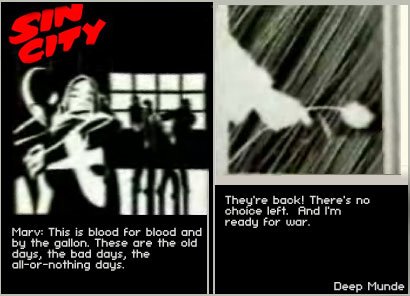Italic = Wider Context
The Man Who Shot Sin City
How Robert Rodriguez, the one-man digital army behind El Mariachi and Spy Kids, brought an "unfilmable" cult comic to the big screen.
By Brian Ashcraft
For years, one of the biggest gets in
When Miller got a call from Robert Rodriguez, A young director known for innovative, inexpensive genre pictures like Desperado and highly technical box office darlings like Spy Kids, Rodriguez made Miller a simple offer: Come to
El Mariachi which he wrote, directed, edited, photographed, and scored for a mere $7,000. Originally intended for the Spanish straight-to-video market, the movie was picked up for distribution by Columbia Pictures (I) in 1992 and went on to win the Audience Award at the 1993 Sundance Film Festival; it was the lowest-budget film (E) ever released by a major studio.
With his own Sony HD cameras, a Discreet visual effects system, four Avid digital editing machines, and XSI animation modeling software (E), Rodriguez can make truly independent films - and for less money than traditional Hollywood directors. "It's like going back to the old video days," Rodriguez says, "when you could run around in your backyard and shoot a movie." Rodriguez is the first filmmaker since Lucas who's had the confidence and skills to work outside the studio system yet still produce big-budget, effects-laden pictures.(H)
That kind of freedom doesn't come without consequences. A week before Sin City began shooting, the Directors Guild of America (I) called to inform Rodriguez that he and Miller couldn't be listed as codirectors in the movie's credits. It would be a violation of DGA rules. Rodriguez was stunned when the DGA threatened to shut down production. Rather than dump Miller, Rodriguez resigned from the guild.
"Having finished the Spy Kids series," Rodriguez says, "I was looking for a good effects challenge." That's what led him to Miller's Sin City. The series takes readers on an eye-popping tour of an underworld packed with tough cops, femme fatales (R), and seedy lowlifes (N). "The stories were great," he says, "but what grabbed you was the look." Miller's black-and-white chiaroscuro style reflects (M) an artist raised on pulp fiction and old crime movies (G). Every scene takes place at night or in some back alley.
There are absolutely no midtones in the graphic novels, a trait that makes them especially problematic to portray on celluloid. "This movie wouldn't even be possible if I shot it on film," Rodriguez says, explaining how difficult it is to capture pure black and white on camera. His workaround: Shoot the actors against a green screen and add most of the backgrounds digitally in postproduction ("All of the guns and cars are real," Miller points out). Even small details like Sin City's signature "white blood" proved to be an effects challenge. Regular movie blood didn't cut it. Instead, the crew used fluorescent red liquid and hit it with a black light. This allowed Rodriguez to turn the blood "white" in postproduction. Likewise, the novel's few splashes of color proved troublesome. Yellow and green react with green screens, causing color to spill into the background and making them impossible to separate. So during shooting Rodriguez painted the villain, Yellow Bastard, blue - and then colored him yellow in post.
As Rodriguez refines the tools of digital filmmaking - and the liberty that comes with them - others are slow to follow. Rodriguez persuaded his pal Quentin Tarantino to direct a scene in the movie. For Sin City, Tarantino filmed a self-contained segment at Troublemaker (Rodriguez own studio) and learned that high tech means low stress. Rodriguez explains: "Quentin did a scene where the actors are in a car and it's raining. Instead of worrying about all that stuff, the car and the rain were added later, and he could just get the performance." Tarantino now says he'll shoot his own digital feature.

No comments:
Post a Comment